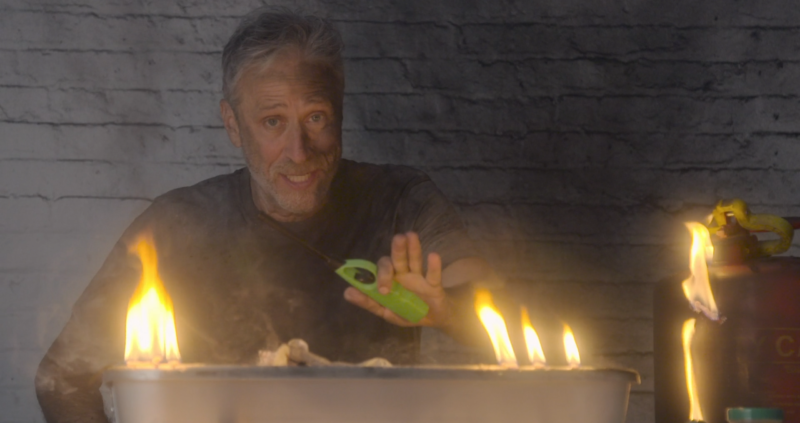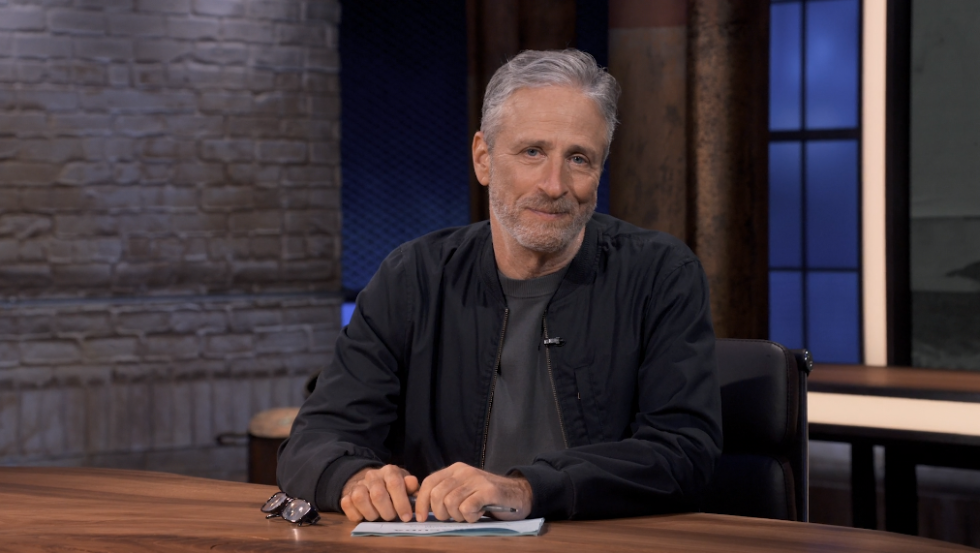
Apple TV+ / Busboy
In Jon Stewart’s first-ever conversation with an Apple TV+ studio audience, he offers a curious send-off—in fact, it argues against the point of his new multi-million dollar hosting deal. “You’re probably just going to look at aggregated clips of” this first episode of The Problem With Jon Stewart, he says, instead of subscribing to Apple TV+. It’s a bit meandering, followed by a joke about pirating episodes of Ted Lasso.
If anybody can show up to a new streaming service and make a joke at the expense of subscriptions, it’s probably Stewart. Online video sharing—and we’re talking the renegade kind, uploaded by fans and shared freely—greatly contributed to The Daily Show‘s massive cultural footprint before Stewart left that show behind in 2015. And as you may have noticed, the TV landscape has dramatically changed since then. These days, every major player is throwing stuff at the video-streaming wall to see what sticks (or, in Quibi’s case last year, what absolutely doesn’t).
So after six years off the “fake news” desk, what path does Stewart and Apple’s new production take? His aforementioned joke may suggest a series that’s meant to be shared and remixed in small clips, but The Problem arrives with a different modus operandi: empathy, not sound bites, and patience, not pulverization. You can arguably pluck out some zingers tailor-made for quick swipes on a service like TikTok, but Stewart seems more invested in relishing the full 44 minutes of each episode. As a result, this fake-news innovator spends the runtime of his new series punting the “fake” out of his reputation, expectations be damned.
Gentle corralling of charged conversations

Apple TV+ / Busboy
At some point today, if not already, the series’ pilot episode will go live, and it revolves around US veterans. In particular, it homes-in squarely on the aggravating issue of “burn pits,” and how the US’s decision to dispose of wartime waste via acres-wide burning sites (reportedly a mix of human flesh, toxic waste, and other trash) appears to have caused cancer in vets who’d toured through Afghanistan and Iraq. The series’s second episode, which lands in two weeks but I’ve also seen, focuses on the general topic of “freedom” and veers in a few directions, ranging from American anti-vaxxers to how free speech is threatened around the world.
Neither begins with a topical, headline-filled monologue, and neither includes chats with stand-up comedians faking as “senior correspondents.” Though both episodes open with a smattering of jokes, often at Stewart’s own expense, it doesn’t take long for him to settle into his apparent dream role: a Dan Rather-caliber newscaster who runs a news program at the local dive bar. F-bombs and pointed drops of “are you #$#$ing kidding me” punctuate his reporting-filled breakdowns of whatever topic’s at hand, and he’s happy to let anger boil over when talking about aggrieved veterans—a topic he’s been front-and-center about in the public eye since testifying on Capitol Hill about the 9/11 First Responders’ bill.
Both episodes include a similar formula: Stewart opens alone at his desk to break down a story, comment on news clips, and alternate between jokes and rants. Then pre-filmed skits emerge during one or two fake commercial breaks. And finally, Stewart hosts a roundtable panel with at least three interviewees, where he’s careful to split the difference between letting guests open up about their expertise and interrupting to move the conversation along. The latter is easily the best part in this early series gestation period, and it plays out almost exactly like you might expect from someone who previously made criticism of Crossfire and Fox News an extracurricular hobby. Any American who has ever tuned-in to overseas cable news panel discussions and thought, “Oh, this isn’t awful” will appreciate Stewart’s gentle corralling of these charged conversations.